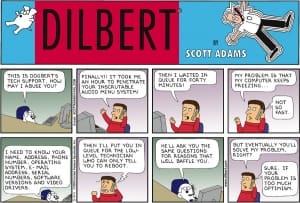Understanding employee engagement surveys
Employee surveys are widely used to help organisational leaders and HR practitioners understand how their staff are feeling and thinking. The central concept to ...
Benchmarking board performance: 500 board reviews later
Unlock evidence-based insights into board performanceIT, it’s one of those things you don’t really notice until something goes wrong. And when this happens it can have a huge impact on productivity, efficiency, customer relationships and even employee engagement.
During my time as an IT professional, I’ve seen how a well run IT environment leads to increased employee engagement. Employees expect a professional set of tools and systems that allow them to do their job properly, and organisations willing to invest in IT will reap the benefits from engaged people. I’ve also seen how failure in this area can be the cause of ongoing frustration that affects the organisation’s culture and overall employee engagement.


Source: https://dilbert.com/strips/comic/2003-03-02/
When IT doesn’t work it’s often a frustrating time for users. Organisations need to reduce the level of frustration and the likelihood of these issues negatively impacting employee engagement, transparent and frequent communication is important. IT staff should prioritise requests and keep the affected users informed on resolution times with regular updates. They should also find a workaround to allow employees to continue with their work whilst finding a solution to the bigger problem.
Communication is a two-way street, so take the time to find out from users how the IT team can improve their systems and service. An employee survey is one way to collect feedback and actionable data, and it can drill down to specific business units, locations or departments which may experience different levels of IT service. Acting on feedback and communicating changes and upgrades shows commitment to improving the organisation’s productivity levels and employee engagement.
Encourage your IT team to:
Treat users like customers
Actually, they ARE customers. Much like other support functions of an organisation, the IT team exists to make employees’ jobs easier, so your IT team should always be customer-focused.
Acknowledge when a user presents a problem
Demonstrate to staff that a member of the IT team is listening and will do everything in their power to help the user fix their problem.
Keep the user informed
Tell them how their problem is being resolved and make sure they get frequent updates. Otherwise they assume their problem has gone into the ether or is ignored.
Provide workarounds
In instances where the IT problem could take a long time to be resolved, a workaround is a good way to keep users happy until a solution can be found or implemented.
Be proactive
Find out what problems other staff have instead of waiting for the employee to report it.
In summary, making it easy for staff to do their job is often overlooked, but some quick wins can be had for organisations looking to improve employee engagement. Though they may feel disconnected from the rest of an organisation, the IT team plays an important role in influencing employee engagement by:
Pretty simple stuff that organisations big and small can implement.
Employee surveys are widely used to help organisational leaders and HR practitioners understand how their staff are feeling and thinking. The central concept to ...
It doesn't feel good to read these does it? Unfortunately, these comments were made by real employees during very real focus groups. And they typifies employee ...
Where will your capacity to grow and increase performance come from over the next few years? Few would disagree that driving productivity and innovation is vital to ...
Employee retention is a critical issue for many sectors of the economy including retail, hospitality, technology, professional services and community services.
We use cookies to enhance your experience. Further use is considered consent. You can read more about cookies in our Privacy Policy.


You’ll always get a real person when you contact Insync.
Let's get started